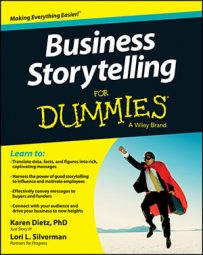A compelling story is critical for any change effort in a business. But a great story from the C-suite isn’t enough. One big mistake leaders make is thinking that what motivates them is what motivates their staff. That’s far from the truth.
Before crafting a compelling story, change efforts start with listening for, evoking, and gathering stories from all levels of the organization. Why? For the story to connect and stimulate action, you have to know your audience.
How to get to know stakeholders through story
Up front, engage in person with audiences who are most likely to be affected by and able to implement the proposed change. Think conversation — give and take. Try the following:
Identify key stakeholders and schedule one-on-one meetings with them.
Craft story prompts in advance that get at what you want to learn.
Evoke stories to learn stakeholders’ needs and points of view.
Share stories of similar experiences, as appropriate. To build trust and rapport, include your own personal stories.
Provide a story that touches on the opportunities that present themselves when the change is ultimately achieved.
Respond to questions stakeholders may have.
How to find stories of pain and urgency
There are two kinds of communications that enterprises often use to launch change. The first says, “Historically we’ve had an advantage over our competitors. This has eroded. Now our customers’ needs are changing. We can regain our leadership position and be prominent once more if we change.”
The second one says, “We’re performing below our competition. To survive, we must dramatically change. We can become a top performer by leveraging our current competencies and focusing on growth.” Both sound like lofty pronouncements from on high. Instead, go deeper with stories.
People embrace change primarily because of pain and urgency. Collecting stories that portray these at various levels creates the contexts for change that are relevant to the different audiences. For example, if the change is to enhance customer service, the pain and urgency related to this in IT probably differs from the pain and urgency associated with it in the marketing group.
Gather real stories of the struggles and challenges that people face because of broken systems, inefficient processes, marketplace threats, consequences for customers, and so on. Connect these struggles to the organization’s potential fate. Distress about the way things currently work provides motivation, more so than the vision of what’s possible.
When gathering these stories, invite people to articulate their understanding of this need for change and bring their passion to it. This will help align them around the purpose of the change.
This is the only time to actively evoke “Ain’t it awful” stories in one-on-one conversations. Be careful here. A steady diet of this kind of story can be debilitating for everyone.
When you hear an “Ain’t it awful” story, never, ever just say, “Thank you” when the person is done telling their tale of woe.
Instead, right after the story is told, ask the person what they’d like to see happen to change it into a better one.
Ask for specific steps that would help get them and others there. You’ll leave the conversation on a high note for both of you and have gained valuable knowledge about the kind of future they want to see and possible paths forward.
Move into providing hope by sharing the future story of what’s possible.
There’s another place to get fodder for stories related to urgency and pain. Go into the future. Do an environmental scan looking out five to ten years. Identify trends, threats, and wildcards — highly unlikely events that would have huge impact if they were to happen. Craft stories for your change based on this information. Tailor stories to the various groups within the organization and to what will propel them forward.
This approach can be useful in all settings, but it’s especially valuable in enterprises that are highly successful but have significant potential upsets looming ahead. Often leaders and staff don’t see any need to change because the organization is doing well.
It’s also beneficial in places where complacency and mediocrity have set in so deeply that employees see such behavior as acceptable. In that situation, having environmental scan data and information to look at can prevent finger-pointing from taking place and undermining the change effort.
Be careful not to stick with the story of the need. Over and over, leaders share an urgent and painful “need for change” story. After staff starts taking action, those same leaders come back and tell the identical change story! Forward progress stalls. Why? These leaders haven’t crafted the next part of the story to engage staff.
How to demonstrate that change is possible
Once you’re assured the organization is embarking on this journey, collect stories in which people survived a personal or organizational change that’s significant to them. Surfacing these stories highlights qualities that got these people through these difficult situations, which pinpoints for other leaders and employees what they’ll need to bring forth for the change effort to succeed.
It also helps folks who hear them overcome feeling lost and anxious as they move into the unknown.
Evoke this kind of “change is possible” story by asking the following questions:
“Tell me about a time when you were faced with an unexpected change in your life and what you did to get you through it successfully.”
“Tell me about a time in your life when you greatly resisted a change, and when you embraced it, many opportunities presented themselves.”
“Tell me about a time when a group you were part of (in the organization or elsewhere) went through a big change that no one thought could be accomplished — yet it was successful — and what made that
A “change is possible” story also conveys the unwavering commitment needed to realize the ultimate outcomes of the change.

